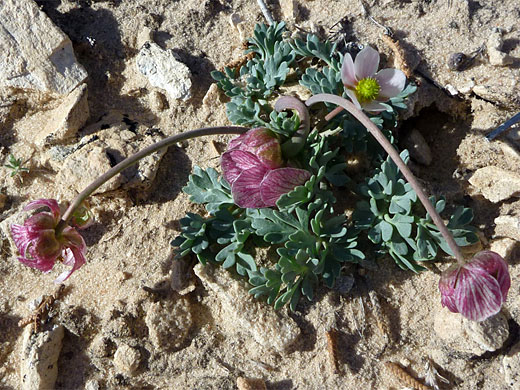Ranunculus Andersonii, Anderson's Buttercup
Plants > Wildflowers > Ranunculaceae > Ranunculus Andersonii

Ranunculus andersonii (Anderson's buttercup); Yellow Rock, Grand Staircase-Escalante National Monument, Utah
Common name:
Anderson's buttercup
Family:
Scientific name:
Ranunculus andersonii
Main flower color:
Range:
The Great Basin, extending into south central Utah
Height:
Between 3 and 7 inches
Habitat:
Dry slopes, sagebrush plains, sandy locations
Leaves:
Basal, cordate, grey-green, divided several times into round-lobed leaflets
Season:
April to May
Most buttercups are yellow or white, but ranunculus andersonii is an exception; the five rounded petals and the five pointed, spreading sepals are pink; very pale at first, becoming steadily darker as they mature. Petals are crossed by darker, lengthwise veins. The center of the flower contains a ring of yellow/orange stamens around a group of greenish pistils. Flowers grow singly at the top of leafless stems, which may be erect or leaning; plants typically produce half a dozen blooms. The basal leaves are heart-shaped in outline, but divided into three leaflets, each split into rounded lobes.
All Contents © Copyright The American Southwest | Comments and Questions | Contribute | Site Map

